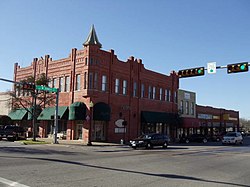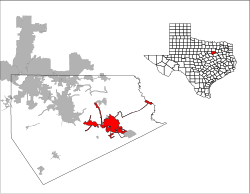Ennis, Texas
| Ennis, Texas | |
|---|---|
| City | |

The Emporium Building at the intersection of Ennis Avenue and Dallas St. in Downtown Ennis.
|
|
 Location of Ennis, Texas |
|
 |
|
| Coordinates: 32°19′56″N 96°37′27″W / 32.33222°N 96.62417°WCoordinates: 32°19′56″N 96°37′27″W / 32.33222°N 96.62417°W | |
| Country |
|
| State |
|
| County | Ellis |
| Government | |
| • Type | Council-Manager |
| • Mayor | Angeline Juenemann |
| • City Manager | Scott Dixon |
| Area | |
| • Total | 28.2 sq mi (73.0 km2) |
| • Land | 27.6 sq mi (71.6 km2) |
| • Water | 0.5 sq mi (1.4 km2) |
| Elevation | 538 ft (164 m) |
| Population (2010) | |
| • Total | 18,513 |
| • Density | 670/sq mi (258.5/km2) |
| Time zone | Central (CST) (UTC-6) |
| • Summer (DST) | CDT (UTC-5) |
| ZIP codes | 75119-75120 |
| Area code(s) | 972 |
| FIPS code | 48-24348 |
| GNIS feature ID | 1335474 |
| Website | www |
Ennis is a city in Ellis County, Texas, United States, located south of Dallas. The population was 18,513 at the 2010 census, up from 16,454 at the 2000 census. The city is notable for its historic Czech heritage, with several community halls dedicated to different fraternities and organizations celebrating Bohemian, Moravian, and Slovak heritage. It is also home to the Bluebonnet Festival, the National Polka Festival, and several National Hot Rod Association drag races at the Texas Motorplex, most notably the AAA Texas NHRA FallNationals.
In 1872 the Houston and Central Texas Railroad (H&TC) arrived at the spot that would become Ennis. The city is named for Cornelius Ennis, an official of the railroad. Ennis served as Mayor of Houston (1856–57), and as a director of the Houston Tap and Brazoria Railway and H&TC.
Between 1874 and 1890, the population grew from 300 to 3,000. Many of the settlers came from the war-torn Confederate States of America and others came from the war-ravaged European nations that later became Czechoslovakia.
In 1891, the H&TC chose Ennis as its northern division headquarters in an agreement requiring that Ennis provide water for the railroad. The machine shops and roundhouse employed several hundred men. One condition of the agreement was that as long as Ennis was able to furnish water the shops could not be moved from the community. The city built the first of three lakes for this purpose in 1892, followed by another in 1895, and the last in 1940
The railroad also led to the expansion of the cotton industry, providing access to foreign and domestic markets through the port of Houston. By 1920, a total of 152,601 bales of cotton were ginned and shipped from Ellis County, the most of any county in America. The Ennis Chamber of Commerce adopted the slogan 'Where Railroads and Cotton Fields Meet."
...
Wikipedia
